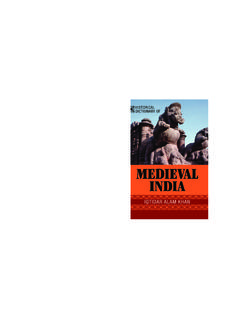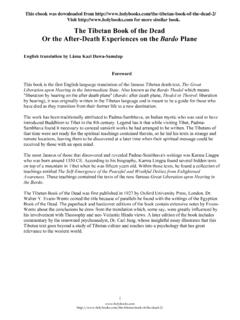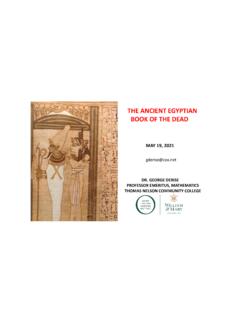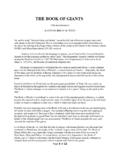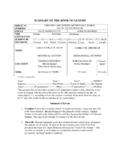Transcription of The Egyptian Book of the Dead (1895) - cultorweb.com
1 Sacred Texts Egypt THE book OF THE DEADThe Papyrus of AnibyE. A. WALLIS BUDGE[1895]Introduction TranslationBecause of the substantial amount of hieroglypics interspersed in the original text, I have omitted the ###'glyph' placeholder where context permits, for readability. Only actual illustations have been inserted intothe file. Due to space considerations the interlinear translation, which is primarily of interest to studentsof Ancient Egyptian , will not be posted. This should not be a hardship, since the Dover reprint edition isstill in print and widely file above, which appears at on the Internet at Sacred-Texts for the first time is a faithful e-text ofthe 1895 edition of the Wallace Budge translation of the Egyptian book of the November of 2000 I inventoried my library and found that I was missing Budge's book of the when a copy of the Dover reprint came up at the local used bookstore, I purchased it.
2 To my dismay,the version of the text widely posted on the Internet did not seem to match the Dover reprint of the to John Mark Ockerbloom, the proprietor of the excellent Online Books Page, the versioncirculating on the Internet is a highly edited version of Budge from a much later date (1913). He writes:"I did a little legwork, and it appears that the "mystery text" is in fact from the Medici Society edition of1913. According to a 1960 reprint by University Books, for this edition "The translation was [and the] greater part of the Introduction was also rewritten by Sir Wallis, who concluded a preface to itwith the pleased words, 'and the entire work thus becomes truly a "New Edition"'". It's unclear whetherBudge himself did the rewrite of the translation, but it's clear that he at least claims responsibility for it,.and it does appear to draw fairly heavily on his earlier translation.
3 "Thanks to Mr. Ockerbloom for clearing up this any case, the version now at sacred-texts is a completely new e-text, which I believe to be a muchbetter version of this PagePrefaceThe Prose Edda (1 of 3) [8/10/2001 11:21:28 AM]ContentsIntroductionThe Versions Of The book Of The Legend Of Doctrine Of Eternal Egyptians' Ideas Of Legend Of Ra And Abode Of The Gods Of The book Of The Principal Geographical And Mythological Places In The book Of The Papyrus Of V. and XI. and XXIII. and Plate XXIX. and XXXI. and Prose Edda (2 of 3) [8/10/2001 11:21:28 AM]Plate XXXIII and XXXV. and Prose Edda (3 of 3) [8/10/2001 11:21:28 AM]Sacred Texts Egypt Index Next THE book OF THE DEADThe Papyrus of AniIN THE BRITISH Egyptian TEXT WITH INTERLINEARTRANSLITERATION AND TRANSLATION,A RUNNING TRANSLATION, INTRODUCTION, A.
4 WALLIS BUDGELate keeper of Assyrian and Egyptian Antiquitiesin the British Museum[1895]scanned at , Oct-Dec : PrefaceTitle [8/10/2001 11:22:23 AM]Sacred Texts Egypt Index Previous Next Papyrus of Ani, which was acquired by the Trustees of the British Museum in the year 1888, is thelargest, the most perfect, the best preserved, and the best illuminated of all the papyri which date fromthe second half of the XVIIIth dynasty (about 1500 to 1400). Its rare vignettes, and hymns, andchapters, and its descriptive and introductory rubrics render it of unique importance for the study of theBook of the Dead, and it takes a high place among the authoritative texts of the Theban version of thatremarkable work. Although it contains less than one-half of the chapters which are commonly assignedto that version, we may conclude that Ani's exalted official position as Chancellor of the ecclesiasticalrevenues and endowments of Abydos and Thebes would have ensured a selection of such chapters aswould suffice for his spiritual welfare in the future life.
5 We may therefore regard the Papyrus of Ani astypical of the funeral book in vogue among the Theban nobles of his first edition of the Facsimile of the Papyrus was issued in 1890, and was accompanied by a valuableIntroduction by Mr. Le Page Renouf, then Keeper of the Department of Egyptian and AssyrianAntiquities. But, in order to satisfy a widely expressed demand for a translation of the text, the presentvolume has been prepared to be issued with the second edition of the Facsimile. It contains thehieroglyphic text of the Papyrus with interlinear transliteration and word for word translation, a fulldescription of the vignettes, and a running translation; and in the Introduction an attempt has been madeto illustrate from native{p. vi} Egyptian sources the religious views of the wonderful people who more than five thousand years agoproclaimed the resurrection of a spiritual body and the immortality of the passages which supply omissions, and vignettes which contain important variations either in subjectmatter or arrangement, as well as supplementary texts which appear in the appendixes, have been, as faras possible, drawn from other contemporary papyri in the British second edition of the Facsimile has been executed by Mr.
6 F. C. A. WALLIS 25, : [8/10/2001 11:22:25 AM]Sacred Texts Egypt Index Previous Next :--THE VERSIONS OF THE book OF THE DEAD ixTHE LEGEND OF OSIRIS xlviiiTHE DOCTRINE OF ETERNAL LIFE lvEGYPTIAN IDEAS OF GOD lxxxiiTHE ABODE OF THE BLESSED ciTHE GODS OF THE book OF THE DEAD cviiGEOGRAPHICAL AND MYTHOLOGICAL PLACES cxxxiiiFUNERAL CEREMONIES cxxxviiiTHE PAPYRUS OF ANI cxliiTABLE OF CHAPTERS cliiiTHE HIEROGLYPHIC TEXT OF THE PAPYRUS OF ANI, WITH INTERLINEARTRANSLITERATION AND WORD FOR WORD TRANSLATION 1-242 TRANSLATION 245-369 BIBLIOGRAPHY 371-377 Next: The Versions Of The book Of The [8/10/2001 11:22:27 AM]Sacred Texts Egypt Index Previous Next VERSIONS OF THE book OF THE four great Versions of the book of the history of the great body of religious compositions which form the book of Dead of the ancientEgyptians may conveniently be divided into four[1] of the periods, which are represented by fourversions:--1.
7 The version which was edited by the priests of the college of Annu (the On of the Bible, and theHeliopolis of the Greeks), and which was based upon a series of texts now lost, but which there isevidence to prove had passed through a series of revisions or editions as early as the period of the Vthdynasty. This version was, so far as we know, always written in hieroglyphics, and may be called theHeliopolitan version. It is known from five copies which are inscribed upon the walls of the chambersand passages in the pyramids[2] of kings of the Vth and VIth dynasties at Sakk ra;[3] and sections of itare found inscribed upon tombs, sarcophagi, coffins, stel and papyri from the XIth dynasty to 200.[4][1. See Naville, Todtenbuch (Einleitung), p. Hence known as the "pyramid texts."3. , Un s, Tet , Pepi I., Mentu-em-sa-f, and Pepi II. Their pyramids were cleared out by MM.]
8 Mariette and Masperoduring the years 1890-84, and the hieroglyphic texts were published, with a French translation, in Recueil de Travaux, , Paris, In the XIth, XIIth, and XIIIth dynasties many monuments are inscribed with sections of the Un s text. Thus lines 206-69are found in hieroglyphics upon the coffin of Amamu (British Museum, No. 6654. See Birch, Egyptian Texts of theEarliest Period from the Coffin of Amamu, 1886. Plates ); Il. 206-14 and 268-84 on the coffin of Apa-ankh,from Sakk ra (see Lepsius, Denkm ler, ii., Bl. 99 b; Maspero, Recueil, t. iii., pp. 200 and 214 ff.); Il. 206-10 {footnotepage x.} and 268-89 on the coffin of Antef (see Lepsius, Denkm ler, ii., Bl. 145; Maspero, Recueil, t. iii., pp. 200, 214);line 206 on a coffin of Menthu-hetep at Berlin (see Lepsius, Aelteste Texte, Bl. 5); lines 269-94 on the sarcophagus ofHeru-hetep (see Maspero, M moires, t, i.)
9 , p. 144). A section is found on the walls of the tomb of Queen Neferu (seeMaspero, Recueil, t. iii., p. 201 ff.; M moires, t. i., p. 134); other sections are found on the sarcophagus of Taka (seeLepsius, Denkm ler, ii., Bll. 147, 148; Maspero, Guide au Visiteur, p. 224, No. 1053; M moires, t. i., p. 134); lines 5-8occur on the stele of Apa (see Ledrain, Monuments gyptiens de la Bibl. Nationale, Paris, 1879, foll. 14, 15); lines 166 found on the stele of Nehi (see Mariette, Notice des Mon. Boulaq, p. 190; Maspero, Recueil, t. iii., p. 195); and lines576-83 on the coffin of Sebek-Aa (see Lepsius, Aelteste Texte, Bl. 37; Maspero, Recueil, t. iv., p. 68). In the XVIII thdynasty line 169 was copied on a wall in the temple of Hatshepset at D r el-bahar (see D michen, Hist. Inschriften, ; Maspero, Recueil, t. i., p. 195 ff.); and copies of lines 379-99 occur in the papyri of Mut-hetep (British Museum,No.
10 10,010) and Nefer-uten-f (Paris, No. 3092, See Naville, Todtenbuch, Bd. I., Bl. 197; Aeg. Zeitschrift, Bd. XXXII., p. 3;and Naville, Einleitung, pp. 39, 97). In the XXVIth dynasty we find texts of the Vth dynasty repeated on the walls of thetomb of Peta-Amen-apt, the chief kher-heb at Thebes (see D michen, Der Grabpalast des Patuamenap in derThebanischen Nekropolis, Leipzig, 1884-85); and also upon the papyrus written for the lady Sais ###, about 200 (seeDev ria, Catalogue des MSS. gyptiens, Paris, 1874, p. 170 No. 3155). Signor Schiaparelli's words are:--"Esso scritto inieratico, di un tipo paleografico speciale: l' enorme abbondanza di segni espletivi, la frequenza di segni o quasi demotici oquasi geroglifici, la sottigliezza di tutti, e l'incertezza con cui sono tracciati, che rivela una mano pi abituata a scrivere inThe Versions Of The book Of The (1 of 36) [8/10/2001 11:22:54 AM]greco che in egiziano, sono altrettanti caratteri del tipo ieratico del periodo esclusivamente romano, a cui il nostro papiroappartiene senza alcun dubbio.


